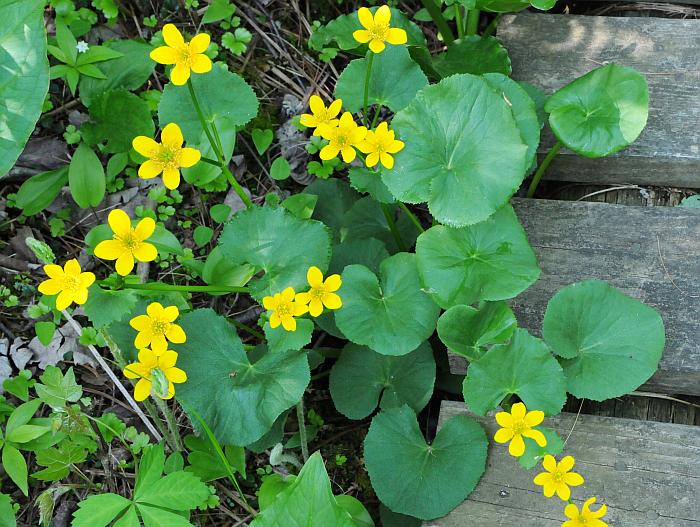Caltha palustris L.
Marsh Marigold

Native
CC = 10
CW = -5
MOC = 1
SRank = S1
© SRTurner
Caltha palustris L.Marsh Marigold | |
 |
Native CC = 10 CW = -5 MOC = 1 SRank = S1 |
© SRTurner |
|
Family - Ranunculaceae Habit - Perennial forb with thick, fleshy roots. Stems - Sprawling, ascending, or erect, to 60 cm, stout, furrowed, hollow, glabrous.
Leaves - Basal and alternate, simple, unlobed, short to long petiolate. Blades 3.0-5.5 cm long, 5-10 cm wide, circular to somewhat kidney-shaped, the base deeply cordate, the tip broadly rounded, the margins finely and usually bluntly toothed.
Inflorescence - Solitary flowers, or open clusters of up to 7 flowers, at stem tips.
Flowers - Actinomorphic, perfect. Sepals 5 or sometimes more, 11-22 mm long, 5-14 mm wide, ovate to obovate, rounded at the tip, plane, yellow, not persistent at fruiting. Petals absent. Stamens numerous, prominent but scarcely showy, the anthers yellow. Staminodes absent. Pistils 3-12, each with about 15 ovules, the style rather short.
Fruits - Cylindrical follicles, the main body 7-10 mm long, the fruit wall thick, prominently veined or not, the outer layer brown to dark brown, the beak 1-2 mm long, straight or curved. Seeds 10-15 per fruit. Receptacle not much enlarged at fruiting, the fruits in a ring.
Flowering - April. Habitat - Wet meadows, swamps. Origin - Native to the U.S. Lookalikes - Ranunculus ficaria. Other info. - This pretty inhabitant of swamps was first reported from Missouri in 1987, from Lafayette County. So far, that is the only reported occurrence in the state. However, farther to our north and northeast, the plant becomes very common. It is found in nearly every county of Michigan, for example, and that is where the above images were obtained. The flowers are typical for plants in the Ranunculus (buttercup) genus, and in fact this plant somewhat resembles Ranunculus ficaria (lesser celandine), except that the flowers of that plant typically have 7-10 petals. The fruits are also multi-seeded follicles rather than the Ranunculus achenes. Photographs taken off Hwy 41, Menominee County, MI., 4-30-04 (DETenaglia); also at Yankee Springs, Barry County, MI, 5-19-2013 (SRTurner). |